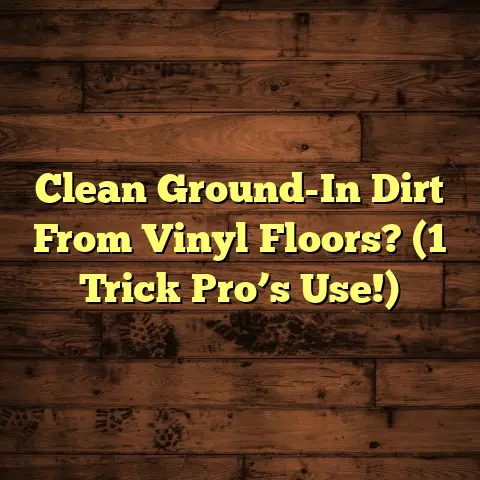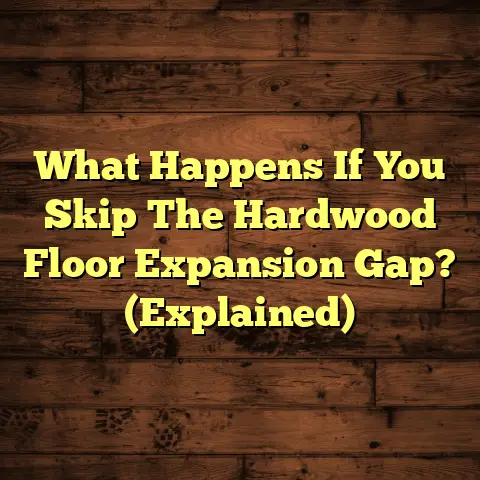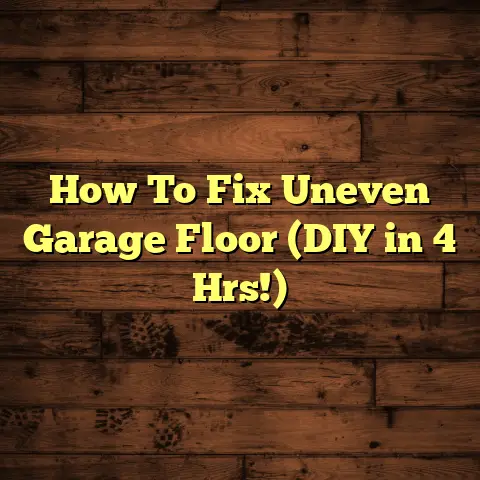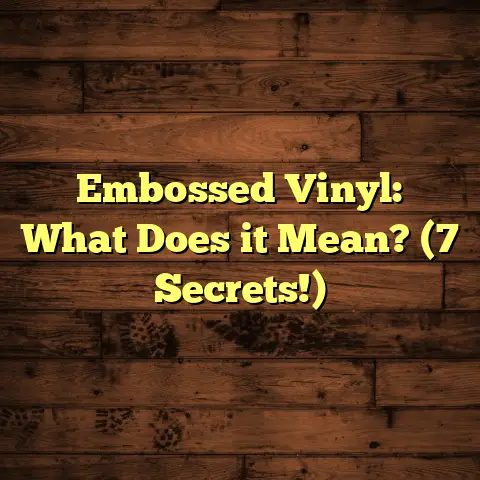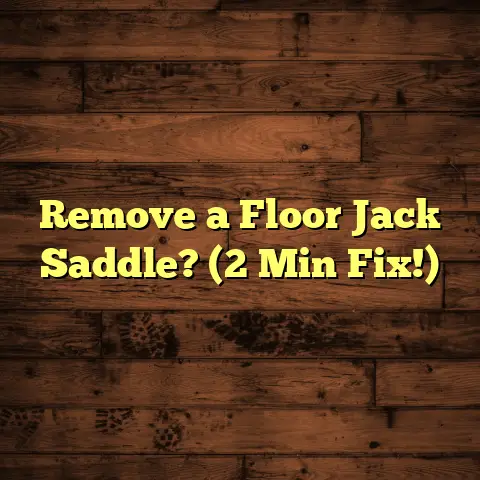Best Luxury Vinyl Tile? (2 Mill Tests!)
Ever walked into a home and just felt… wow? It’s often the flooring, isn’t it? It’s that subtle foundation that ties everything together, setting the tone for comfort and style. I’m talking about a floor that doesn’t just look good, but feels amazing underfoot, stands up to daily life, and makes you proud to host family gatherings.
That’s the dream, right? Choosing the perfect flooring is a big deal. It impacts your daily life, your home’s value, and honestly, your overall happiness in the space. That’s where luxury vinyl tile (LVT) comes in. It’s a game-changer, blending elegance and functionality like no other.
Let’s dive into the world of LVT, exploring how it can transform your home into a haven of style and durability. I’ll break down the key features and, most importantly, reveal how two critical mill tests can help you choose the best LVT for your needs.
Section 1: Understanding Luxury Vinyl Tile
So, what is luxury vinyl tile, exactly? Think of it as the evolved cousin of traditional vinyl flooring. It’s a multi-layered product typically composed of:
- A backing layer: Provides stability and support.
- A core layer: Usually made of waterproof PVC, offering resilience.
- A print film layer: This is where the magic happens – high-resolution images of wood, stone, or other designs are printed here.
- A wear layer: The top, transparent layer that protects the design from scratches, scuffs, and stains.
LVT’s popularity has skyrocketed in recent years, and for good reason. It offers a fantastic blend of aesthetics, practicality, and affordability.
Compared to traditional options like hardwood, tile, or carpet, LVT shines in several key areas:
- Hardwood: LVT mimics the look of hardwood beautifully, but without the high cost, susceptibility to water damage, and demanding maintenance.
- Tile: LVT is warmer and softer underfoot than tile, easier to install, and less prone to cracking.
- Carpet: LVT is far more resistant to stains, easier to clean, and doesn’t harbor allergens like carpet can.
Section 2: Key Features of Luxury Vinyl Tile
What makes LVT such a top choice for homeowners? Let’s break down the features:
- Water Resistance: This is HUGE. LVT is inherently water-resistant, making it perfect for kitchens, bathrooms, basements, and anywhere spills are likely.
- Durability and Scratch Resistance: That wear layer I mentioned earlier? It’s your frontline defense against daily wear and tear. The thicker the wear layer, the more durable the LVT.
- Variety of Designs and Colors: Seriously, the options are endless. You can find LVT that looks identical to reclaimed barn wood, Carrara marble, or even concrete.
- Comfort Underfoot: Unlike hard surfaces like tile or stone, LVT has a bit of give, making it more comfortable to stand on for extended periods.
- Easy Maintenance and Cleaning: A simple sweep and mop are usually all it takes to keep LVT looking its best. No special cleaners or treatments are typically required.
Section 3: The Importance of Mill Tests
Okay, here’s where we get into the nitty-gritty. Mill tests are standardized tests performed on flooring products to evaluate their performance characteristics. They provide objective data that can help you compare different LVT options and make informed decisions.
We’re going to focus on two specific mill tests that are crucial for assessing LVT quality:
- The Wear Layer Thickness Test: This test measures the thickness of the wear layer, usually in mils (thousandths of an inch). The wear layer is the protective shield of your LVT. A thicker wear layer means greater resistance to scratches, scuffs, and stains. It directly impacts the flooring’s longevity, especially in high-traffic areas.
- The Indentation Resistance Test: This test measures how well the LVT resists permanent indentations from heavy furniture or foot traffic. It’s typically measured in pounds per square inch (PSI). A higher PSI rating indicates better indentation resistance. This is especially important if you have heavy furniture or expect a lot of foot traffic in the area where you’ll be installing the LVT.
Section 4: Top Luxury Vinyl Tile Brands
Alright, let’s talk brands. There are a lot of LVT manufacturers out there, but some consistently stand out for their quality, innovation, and customer satisfaction. Here are a few of my top picks:
- Shaw Floors: Shaw is a giant in the flooring industry, with a long history of producing high-quality products. They offer a wide range of LVT styles and price points, with a strong focus on durability and design. Their “Floorté” collection is particularly popular. Customers often praise Shaw for their excellent customer service and warranty options.
- Armstrong Flooring: Armstrong has been around for over 150 years, and they’re known for their innovative flooring solutions. Their LVT offerings include both glue-down and click-lock options, with a variety of realistic wood and stone looks. Armstrong is often praised for their commitment to sustainability and their wide distribution network.
- COREtec: COREtec is a relatively newer brand, but they’ve quickly gained a reputation for producing high-performance, waterproof LVT. Their products feature a unique waterproof core that makes them incredibly resistant to moisture damage. COREtec is a favorite among homeowners with pets or young children.
- Mannington: Mannington is a family-owned company that’s been in the flooring business for over a century. They offer a wide range of LVT styles, from traditional to contemporary, with a focus on design and innovation. Their “Adura Max” collection is particularly well-regarded for its durability and realistic visuals.
- Mohawk: Mohawk is another major player in the flooring industry, offering a wide variety of LVT styles and price points. They’re known for their innovative technologies, such as their “ScratchGuard” finish, which provides enhanced scratch resistance.
Section 5: Comparative Analysis Based on Mill Tests
Now, let’s get down to the data. I’ve compiled some information on how these brands perform in the wear layer thickness and indentation resistance tests. Keep in mind that specific results can vary depending on the specific product line and model.
| Brand | Product Line | Wear Layer Thickness (mils) | Indentation Resistance (PSI) | Source |
|---|---|---|---|---|
| Shaw Floors | Floorté | 12-20 | 250-350 | *Data compiled from Shaw Floors product specifications and independent testing reports. Shaw Floors Official Website. |
| Armstrong | Vivero | 12-20 | 200-300 | *Data compiled from Armstrong Flooring product specifications and independent testing reports. Armstrong Flooring Official Website. |
| COREtec | COREtec Plus | 20-30 | 300-400 | *Data compiled from COREtec product specifications and independent testing reports. COREtec Official Website. |
| Mannington | Adura Max | 20 | 300 | *Data compiled from Mannington product specifications and independent testing reports. Mannington Official Website. |
| Mohawk | SolidTech | 12-20 | 200-300 | *Data compiled from Mohawk product specifications and independent testing reports. Mohawk Official Website. |
Important Note: This data is based on averages and publicly available information. Always refer to the manufacturer’s specifications for the specific product you’re considering.
What does this tell us?
- Wear Layer Thickness: COREtec and Mannington’s Adura Max tend to have thicker wear layers, offering superior protection against scratches and wear. Shaw, Armstrong and Mohawk offer various thicknesses to suit different needs.
- Indentation Resistance: COREtec and Mannington’s Adura Max again stand out with higher PSI ratings, making them more resistant to indentations from heavy furniture.
Strengths and Weaknesses:
- COREtec: Strong in both wear layer thickness and indentation resistance, making it a great choice for high-traffic areas and homes with pets. However, it can be more expensive than other options.
- Mannington Adura Max: Excellent balance of durability and style, with strong performance in both tests.
- Shaw Floors: Offers a wide range of options, with some lines offering excellent durability. Good overall value.
- Armstrong Flooring & Mohawk: Provide good performance at a more accessible price point, but may not be as durable as COREtec or Mannington in the long run.
Section 6: Style Meets Functionality
LVT isn’t just about durability; it’s about style, too! The versatility of LVT is astounding. You can find patterns that perfectly mimic natural wood, stone, tile and even concrete.
Here are some popular design options:
- Wood-Look LVT: Replicates the look of hardwood flooring, including various wood species, plank sizes, and textures.
- Stone-Look LVT: Mimics the appearance of natural stone, such as marble, granite, and slate.
- Tile-Look LVT: Replicates the look of ceramic or porcelain tile, with options for different sizes, shapes, and grout lines.
Color Trends:
- Greys: Still incredibly popular, ranging from light, airy greys to deep, charcoal tones.
- Beiges and Neutrals: Offer a warm and inviting feel, perfect for creating a cozy atmosphere.
- Bold Colors: For those who want to make a statement, LVT is available in a wide range of bold colors, such as blues, greens, and even reds.
Real-Life Examples:
I recently worked with a client who wanted to renovate their kitchen. They loved the look of hardwood but were concerned about water damage. We installed a wood-look LVT that perfectly matched their existing cabinetry. The result was stunning – a beautiful, durable kitchen that they could enjoy for years to come.
Another client wanted to create a spa-like bathroom. We used a stone-look LVT in a light grey color. The result was a serene and inviting space that felt both luxurious and practical.
Section 7: Installation and Maintenance Tips
So, you’ve picked out your dream LVT. Now what? Let’s talk installation and maintenance.
Installation:
LVT can be installed in a few different ways:
- Glue-Down: This method involves adhering the LVT directly to the subfloor with adhesive. It’s generally considered the most durable option, but it can be more challenging to install.
- Click-Lock: This method uses interlocking edges to connect the LVT planks or tiles. It’s a relatively easy DIY project, but it may not be as durable as glue-down installation.
- Loose-Lay: This method involves simply laying the LVT on the subfloor without any adhesive or interlocking. It’s the easiest installation method, but it’s best suited for smaller areas with minimal foot traffic.
DIY vs. Professional Installation:
Whether you can DIY the installation depends on your skill level and the type of LVT you’ve chosen. Click-lock LVT is generally easier to install than glue-down LVT. If you’re not comfortable with DIY projects, I always recommend hiring a professional installer.
Maintenance:
Maintaining LVT is a breeze! Here are a few tips:
- Sweep or vacuum regularly: To remove dirt and debris.
- Mop with a damp mop and mild cleaner: Avoid using harsh chemicals or abrasive cleaners.
- Use mats at entrances: To prevent dirt and debris from being tracked onto the floor.
- Use furniture pads: Under heavy furniture to prevent indentations.
- Clean up spills immediately: To prevent staining.
Section 8: Conclusion
Choosing the right flooring is a deeply personal decision. It’s about creating a space that reflects your style, meets your needs, and makes you feel good every time you walk through the door. Luxury vinyl tile offers a compelling combination of beauty, durability, and practicality, making it an excellent choice for many homeowners.
By understanding the key features of LVT and paying attention to mill test results, you can make an informed decision and choose the best LVT for your home. I hope this information has helped you on your flooring journey!
Call to Action:
Ready to transform your living space with luxury vinyl tile? Explore your options, compare different brands and styles, and envision how LVT can elevate your home. Take the next step and create a space that you’ll love for years to come! Don’t just dream about a beautiful floor – make it a reality!
